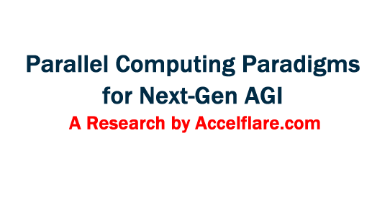
Accelflare
Project Ownerwww.accelflare.com
DEEP Connects Bold Ideas to Real World Change and build a better future together.
Coming Soon
This project explores next-generation computing paradigms—such as analog, temporal, and in-memory architectures—for accelerating symbolic AGI systems. Through structured evaluation and benchmarking, we aim to identify architectures capable of supporting parallel symbolic workloads in reasoning, inference, and attention mechanisms. Using our Symbolic AGI Toolkit and CQ Tester, we will assess feasibility, performance, and integration potential. Outcomes will include research insights, benchmark criteria, and a prototype demonstration aligned with AGI development goals.
The purpose of this RFP is to identify, assess, and experiment with novel computing paradigms that could enhance AGI system performance and efficiency. By focusing on alternative architectures, this research aims to overcome computational bottlenecks in recursive reasoning, probabilistic inference, attention allocation, and large-scale knowledge representation. Bids are expected to range from $40,000 - $80,000.
Hardware Paradigm Mapping & AGI Task Alignment: Survey and select candidate hardware paradigms (e.g. analog in-memory temporal race logic). Design a research strategy that maps AGI symbolic workloads—including recursive reasoning FSM chains and Regex interpretation—onto these paradigms.
Detailed research plan Symbolic task catalog and alignment matrix Diagram of AGI task flow mapped to each hardware paradigm
$10,000 USD
Comprehensive justification for each paradigm’s relevance Clearly defined benchmarking methodology Approval-ready roadmap for experimentation
Symbolic Hardware Suitability & Benchmarking Metrics: Conduct an in-depth literature review of the selected paradigms focused on symbolic execution attention shifts and recursive inference. Define benchmark metrics for evaluating symbolic processing across AGI workloads.
Annotated literature summary Benchmarking matrix (performance scalability symbolic traceability) Symbolic task simulation scenarios
$10,000 USD
At least 4 paradigms deeply analyzed Formal benchmark definitions for FSM/Regex/CQ tasks Validation-ready testing criteria for Milestone 3
Symbolic Execution Simulations and Feasibility Trials: Build simulation environments or use hardware-software co-design tools to evaluate AGI-relevant tasks under each paradigm. Focus on task fidelity performance efficiency and symbolic integrity.
FSM/Regex/CQ test execution logs Symbolic task graphs before/after execution Performance and symbolic consistency reports
$10,000 USD
Successful symbolic task simulation on at least two paradigms Feasibility ratings based on benchmark metrics Evidence of symbolic traceability through execution
Comparative Review and AGI Integration Prototype: Synthesize findings into a comparative evaluation report. Build a prototype or symbolic proof-of-concept demonstrating how one selected paradigm can accelerate symbolic AGI tasks.
Final evaluation report with symbolic integration mapping Working prototype or co-simulation model Summary recommendations for future AGI hardware research
$10,000 USD
Prototype demonstrates successful symbolic execution Paradigm shown to improve AGI task throughput or efficiency Deliverables suitable for future AGI infrastructure proposals
Reviews & Ratings
Please create account or login to write a review and rate.
Check back later by refreshing the page.
© 2025 Deep Funding
Join the Discussion (0)
Please create account or login to post comments.